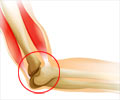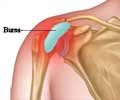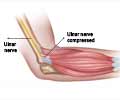- Shoulder Problems and Injuries - (https://www.uofmhealth.org/health-library/shoul)
- Sprains and Strains - (https://www.niams.nih.gov/health-topics/sprains-and-strains)
- Shoulder Impingement Syndrome - (https://en.wikipedia.org/wiki/Shoulder_impingement_syndrome)
- Hand Pain and Conditions - (https://www.medstarunionmemorial.org/our-services/the-curtis-national-hand-center/conditions-hand-pain/)
- About Sprains and Strains - (https://medlineplus.gov/sprainsandstrains.html)
What is Sprain in the Arm?
A sprain is a condition that occurs due to excessive stretching, twisting or tearing of a ligament due to heavy force on the joint. A sprained arm refers to sprain of ligaments in the shoulder joint or the elbow joint or both.(1✔ ✔Trusted Source
Sprains and Strains
Go to source)
Shoulder joint consists of three bones namely, Clavicle, Scapula and Humerus. It takes two joints namely acromioclavicular joint and glenohumeral joint to produce movement in the shoulder. The glenohumeral joint is a ball and socket joint and is covered by a synovial membrane.
Elbow joint is formed with three bones namely, Humerus, Radius and Ulna. It is a synovial hinge joint.
What Causes Arm Sprain?
Arm sprain can happen due to a blow to the joint, falling on an out-stretched arm or forceful twisting of the arm. Sprained arm refers to sprain in the shoulder or/and elbow joints.
Common symptoms of an arm sprain are swelling, pain, redness and tenderness in the joint. Reduced range of motion in the joint is also present. Slight movement can aggravate pain.
Shoulder Sprain: Sports, and any job that involves lifting of heavy objects, connective tissue disorders and conditions with reduced muscle strength increase the risk of developing shoulder sprain. Pain is usually located in front of the joint; it aggravates even with the slightest movement or pressure over that area.
Elbow Sprain: Its common occurrence in sports like gymnastics or baseball; it can develop, due to poor coordination or balance, inadequate flexibility or strength in the muscles, ligaments and connective tissue disorders(2✔ ✔Trusted Source
Shoulder Problems and Injuries
Go to source). Elbow sprains are graded depending upon the severity of the injury:
- Grade 1 Some amount of stretching with minimal tearing of the ligament is present.
- Grade 2 Partial tearing of the ligament is present.
- Grade 3 Complete tearing of the ligament is present.
Conditions That Mimic Symptoms of a Sprain in the Arm:
- Frozen Shoulder or Adhesive Capsulitis: It causes pain and stiffness in the shoulder joint. It occurs due to the thickening and tightening of the capsule of connective tissue that is present around the bones, ligaments and tendons in the shoulder joint. Therefore, there is restriction of movement in the joint. People who are more prone to developing frozen shoulder are those aged over 40 years and those with immobility and systemic diseases like diabetes, overactive/underactive thyroid, tuberculosis and cardiovascular diseases. Physical examination, X- rays and MRI are helpful in diagnosing the condition.
- Shoulder Impingement or Rotator Cuff Tendinitis: It is the inflammation of the tendons of the rotator cuff muscles while they pass through the subacromial space. Bony spurs, osteoarthritis spurs, abnormalities in the structure of the acromion, thickening of the coracoacromial ligament or the subacromial bursa, and injury to the rotator cuff muscles are commonly involved in the occurrence of shoulder impingement syndrome. Pain, weakness and loss of movement are often present in the affected joint. Physical exam, ultrasound, Arthrogram and MRI are often useful in concluding on the diagnosis.(3✔ ✔Trusted Source
Shoulder Impingement Syndrome
Go to source)
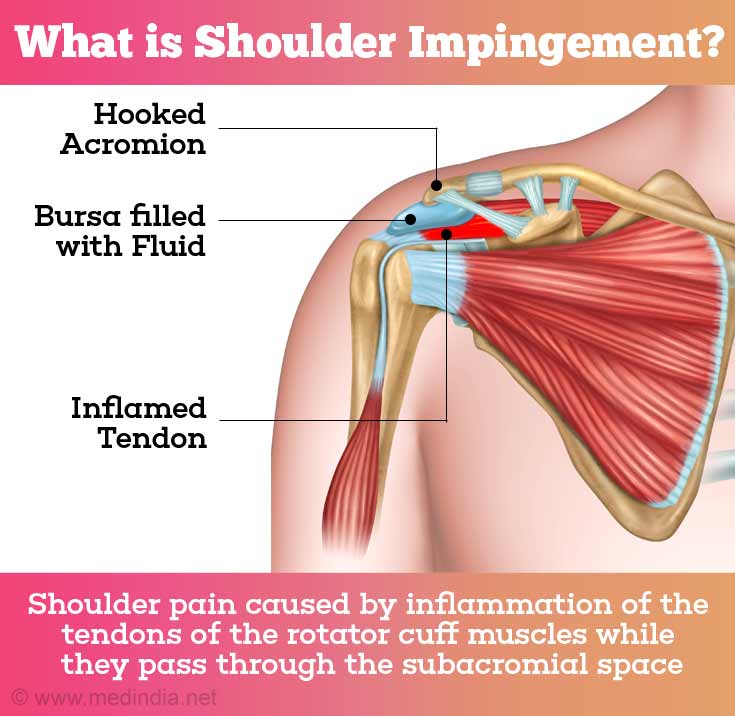
- Subacromial Bursitis: It is the inflammation of the bursa lying between the superior surface of the supra-spinatus tendon and coraco-acromial ligament. It is characterized with shoulder pain located in the front and side, weakness and stiffness in the joint.
- Brachial Plexus Injury: It is the injury to the network of nerves (brachial plexus) that carries signals from the spine to the shoulder, arm and hand. It can be caused by various factors like injuries while playing football, automobile accidents, difficult births (breech presentation, prolonged labor), tumors and radiation. A rare condition called Parsonage-Turner syndrome causes similar symptoms without any apparent injury. It gives an electric shock-like or burning sensation that travels down the arm, weakness, numbness, loss of movement, loss of sensation in the arm and severe pain.
- Cervical Radiculopathy: It is the injury or compression of the nerves arising from the cervical spine. Symptoms depend on the extent of injury and the nerve injured. Bone spurs, arthritis, spondylosis and aging can cause cervical radiculopathy. Sharp pain traveling down the arm with pins and needles sensation and weakness are commonly manifested with this condition. Symptoms worsen with turning of the head and straining of the neck.
- Pigmented Villonodular Synovitis: It is the thickening, inflammation and overgrowth of the synovium surrounding the shoulder or the elbow joint leading to bone damage and arthritis. It can be localized or diffuse in the joint. Symptoms include swelling with pain, stiffness, locking, catching and instability in the joint.
- Tennis Elbow or Lateral Epicondylitis: It is the inflammation or degeneration of tendon tissue that is attached to the extensor muscles of the lateral epicondyle. Pain is commonly located over the outer side of the elbow. It increases with gripping or activity. X–rays and physical examination help in concluding the cause.
- Olecranon Bursitis: It is the inflammation of the bursa located at the joint space that is useful for cushioning the bones, tendons and muscles in the elbow joint. It is characterized with swollen red joints that are painful and stiff. Slight movement or pressure over that area aggravates the pain. Repeated lifting of objects over the head and leaning for long periods on the elbows increases the risk of developing bursitis. Ultrasound and MRI are useful in diagnosing the condition.
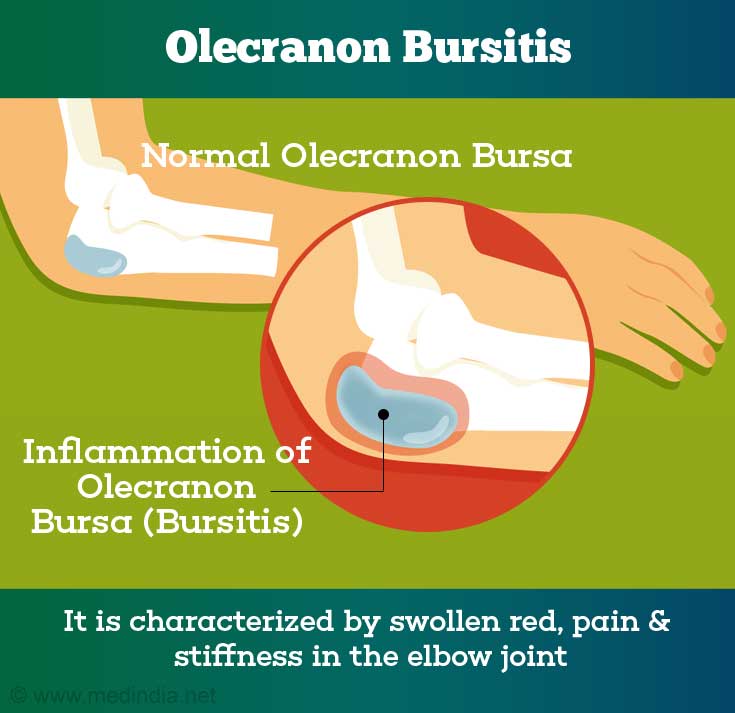
- Golfers Elbow or Medial Epicondylitis: It is the inflammation of the tendon attached to the flexor muscles of the medial epicondyle. It causes pain on the inner side of the elbow and it increases with gripping. Stiffness, weakness, tingling and numbness may also be present. X-rays and physical examination help in concluding the cause.
- Fractures in the arm: Fracture is a break in the bone. Fractures can occur in the humerus radius and ulna. Fractures are usually a result of trauma, physical abuse, aging or osteoporosis. Severe pain with deformity, decreased range of motion, swelling and bruising are common with fractures in the arm. X-rays are useful in confirming the location of the fracture.
- Dislocation: Shoulder dislocation is common with forceful backward pull or extreme rotation. In shoulder instability, dislocation can occur frequently. When the dislocation is incomplete, it is called as Subluxation. Elbow dislocation can happen due to a fall on an out stretched arm or with an automobile accident. Deformed joint and severe pains are common with dislocated bones in the arm.
- Nerve Entrapment Syndromes: Nerve entrapment or compression syndromes arise due to compression of the nerves that pass through the elbow towards the forearm namely median, ulnar and radial nerves.
- Cubital Tunnel Syndrome: It is caused by ulnar nerve entrapment or compression. It presents with numbness, tingling sensation in the ring and little fingers of the hand on the affected side. Weakness, claw like fingers are also common in this condition.
- Radial Tunnel Syndrome: It's a condition in which radial nerve is compressed. Symptoms are pain on the outer side of the elbow travelling towards the fore arm. Both these conditions are diagnosed with physical examination, nerve conduction studies (NCS) and electromyography (EMG).
- Arthritis: It is the inflammation of the joint space. It can be a result of infection, osteoarthritis,
rheumatoid arthritis or other connective tissue disorders. Pain, stiffness and reduced range of motion in the joint are common with arthritis.
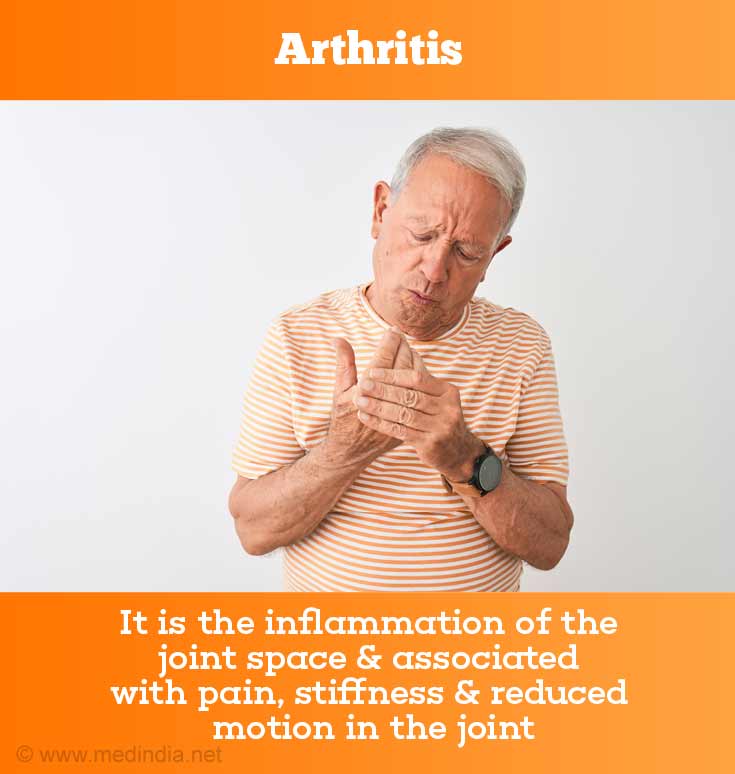
- Pseudogout: It is a form of arthritis caused due to deposition of calcium pyrophosphate crystals in the joint space.(4✔ ✔Trusted Source
Hand Pain and Conditions
Go to source)
How is Sprain in the Arm Diagnosed?
Sprained arm is diagnosed with X–rays, MRI, arthrogram and CT scan.
How is Sprain in the Arm Treated?
Sprained arm is treated with rest, applying ice pack, compression and elevation. Taking electrotherapy treatments like ultrasound or laser and using NSAIDs provide pain relief. Supportive brace or sling is usually applied. Rehabilitation exercises are also recommended to strengthen the ligaments. In case of a completely torn ligament or instability or dysfunction of the joint, surgical treatment is recommended.(5✔ ✔Trusted Source
About Sprains and Strains
Go to source)
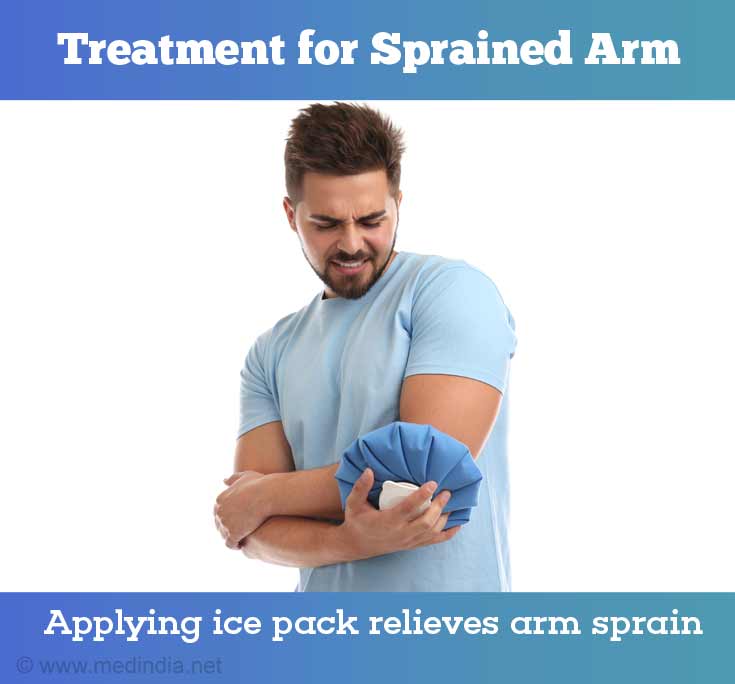
Sprain in the Arm - Health Tips
- Wear supportive equipment while playing sports.
- Wear protective padding while playing high-impact sports.
- Practice the right technique to avoid injuries.
- Practice strengthening exercises. Always do warm-up exercises before playing sports.



